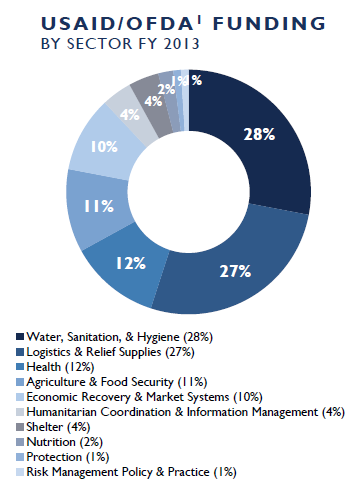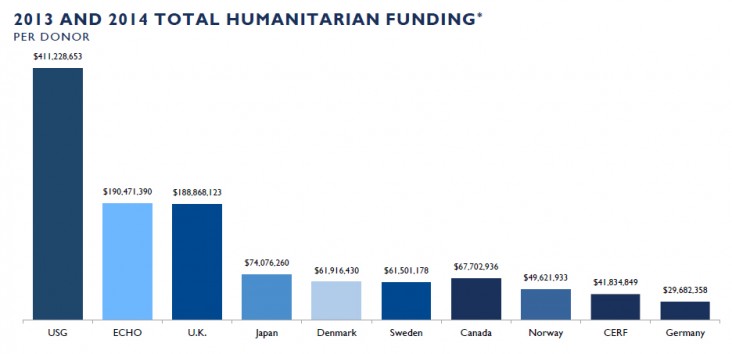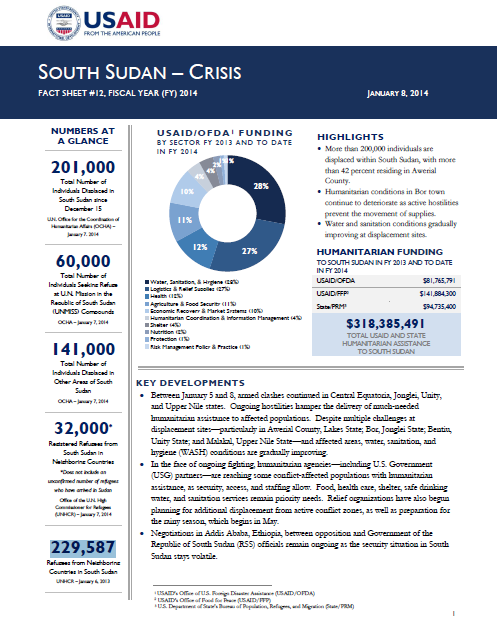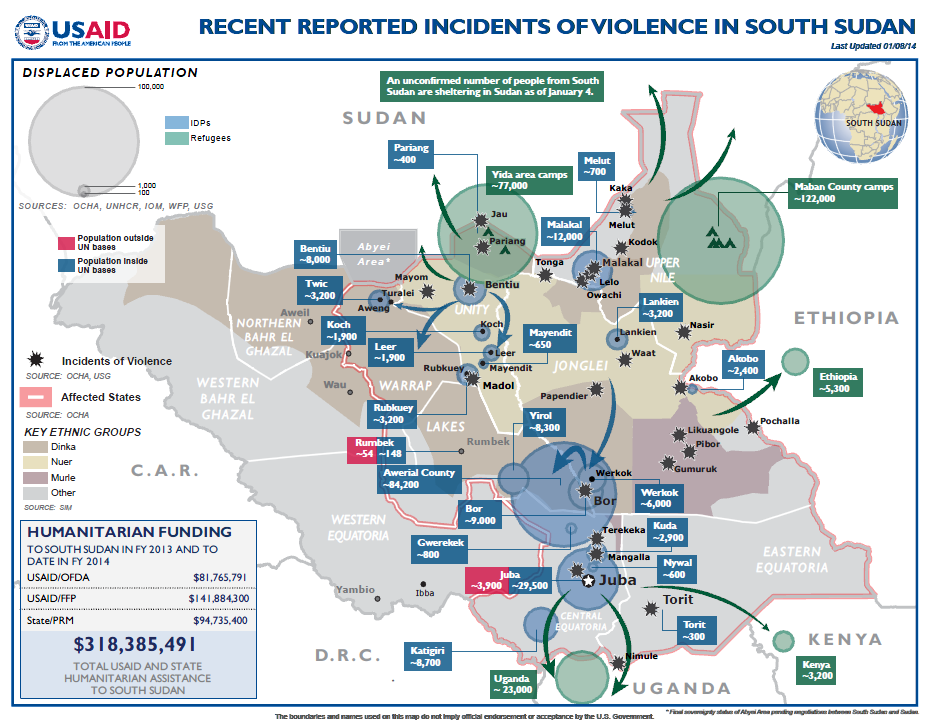- What We Do
- Agriculture and Food Security
- Democracy, Human Rights and Governance
- Economic Growth and Trade
- Education
- Environment and Global Climate Change
- Gender Equality and Women's Empowerment
- Global Health
- Humanitarian Assistance
- Transformation at USAID
- Water and Sanitation
- Working in Crises and Conflict
- U.S. Global Development Lab
Speeches Shim
January 9, 2013
Numbers At A Glance
201,000
60,000
141,000
32,000
229,587
Humanitarian Funding:
To South Sudan To Date In FY2013 and FY2014:

| USAID/OFDA | $81,765,791 |
| USAID/FFP | $141,884,300 |
| State/PRMDoD | $94,735,400 |
| TOTAL | $318,385,491 |
Highlights
Three flights deliver critical food supplies to Bor, Jonglei State, but access to Bor remains difficult.
The CERF allocates $15 million to support ongoing relief activities.
Conflict since December 15 has destroyed markets and disrupted trade flows, significantly affecting food access.
KEY DEVELOPMENTS
Ongoing hostilities in many areas of South Sudan continue to impede the delivery of critical humanitarian assistance to vulnerable populations. Despite constraints, humanitarian agencies are providing support as access and security allow. On January 8, three flights delivering food supplies arrived in Bor, Jonglei State, where more than 9,000 individuals are sheltering in the UNMISS base, according to the U.N. Insecurity has impeded the delivery of much-needed relief supplies to Bor for several days.
On January 9, the Central Emergency Response Fund (CERF) allocated $15 million to support ongoing relief efforts in South Sudan.
Continued clashes since December 15 have negatively impacted food security in South Sudan, with most-affected populations residing in Jonglei, Upper Nile, and Unity states, likely experiencing Crisis—IPC Phase 3—and possibly Emergency—IPC Phase 4—levels of acute food insecurity in the coming months if conflict and diminished food access persist.4 Continued clashes are preventing assessments to confirm food insecurity levels. USAID/FFP grantee the U.N. World Food Program (WFP) and other partners are distributing food supplies as security, access, and staffing permit.
SITUATION AND DISPLACEMENT UPDATE
The U.N. reports heavy fighting broke out on January 8 between Sudan People’s Liberation Army (SPLA) and opposition forces in Mayom County, Unity State, forcing additional population displacement. Additional people sought shelter at the UNMISS compound east of Mayom in Bentiu, Unity, which is already hosting approximately 8,000 internally displaced persons (IDPs). The U.N. also reports that recent fighting in other areas of Unity State has displaced populations to Warrap State, including 3,200 people to Twic County.
With no additional reports of gunfire in the capital city of Juba, Central Equatoria State, since January 5, the situation has calmed but remains tense, the U.N. reports.
As of January 7, at least 32,000 South Sudanese refugees had arrived in Uganda, Ethiopia, and Kenya, with an unconfirmed number of refugees arriving in Sudan, according to the U.N.
The humanitarian community continues to prioritize food, health care, shelter, and water, sanitation and hygiene (WASH) interventions and is engaging in contingency planning efforts for a potential increase in IDP and refugee numbers in the coming months.
HUMANITARIAN RESPONSE IN JUBA, CENTRAL EQUATORIA STATE
South Sudan Crisis Fact Sheet #13 January 9, 2014 ![]() (pdf - 398k)
(pdf - 398k)
WASH conditions continue to improve at the two UNMISS bases in Juba—Tong Ping and U.N. House 3—where more than 24,000 IDPs are seeking shelter. IDPs in both Juba UNMISS bases are receiving approximately 15 liters of safe drinking water per day, in-line with international Sphere standards5, and cases of acute watery diarrhea have decreased significantly, according to UNMISS. At U.N. House 3, nearly 270 latrines and more than 110 bathing areas are functioning, while at Tong Ping, 230 latrines are available and a 20-person hygiene promotion team is in place, according to the U.N.
The U.N. reports the need for additional emergency relief supplies and shelter materials in Juba, where approximately 2,500 individuals have sought shelter at a church. As of January 7, relief agencies had distributed household kits to nearly 8,700 families, with distribution ongoing, in Juba and constructed 26 communal shelters in the UNMISS Tong Ping base to house 1,300 IDPs.
Relief agencies are continuing to screen children arriving at the UNMISS bases in Juba for malnutrition, with referral processes in place for children requiring treatment.
The U.N. notes that the UNMISS level 2 hospital at the UNMISS Tong Ping base, which is treating trauma patients from Juba and other affected areas throughout Sudan, has exceeded treatment capacity. Health partners report the need to identify additional sites to provide surgical treatment for conflict-affected populations.
HUMANITARIAN NEEDS AND RESPONSE IN OTHER AREAS OF SOUTH SUDAN
South Sudan Crisis Map January 9, 2014 ![]() (pdf - 423k)
(pdf - 423k)
Clashes across South Sudan since December 15 have affected internal and cross-border trade flows, destroyed local market infrastructure, and disrupted South Sudan’s main sorghum harvest, according to the USAID-funded Famine Early Warning System Network (FEWS NET). Expected below-average harvests in some areas; reduced grain flows from Sudan, Uganda, and Ethiopia; and high levels of population displacement are likely to further impact food security in the coming months. If conflict and resultant impacts on food access persist, Crisis—IPC Phase 3—is likely among the worst-affected populations, particularly in Jonglei, Upper Nile and Unity states. Emergency—IPC Phase 4—levels of acute food insecurity are possible in the coming months if violence and diminished food access persist, according to FEWS NET.
Three flights delivering food arrived in Bor, Jonglei State, on January 8, where more than 9,000 individuals are sheltering in the UNMISS base, according to the U.N. The flights also evacuated 54 individuals to Juba for medical treatment. In recent days, insecurity has restricted flights from landing in Bor, where humanitarian agencies reported an increasingly urgent need for food, medical supplies, and other humanitarian assistance.
In recent weeks, health partners have conducted nearly 9,800 health consultations across areas of displacement in South Sudan, reporting respiratory tract infections, suspected malaria cases, and acute diarrhea as the leading causes of illness across conflict-affected populations residing in Awerial, Lakes State; Bentiu, Unity State; Juba, Central Equatoria State; and Malakal, Upper Nile State. Agencies are developing more robust health promotion and prevention activities for implementation in displacement sites.
The U.N. reports the need for emergency relief supplies and shelter materials in many affected areas, including at the UNMISS Base in Bentiu, Unity State; Malakal, Upper Nile State; and Waat, Jonglei State. Despite ongoing gaps, 60,000 individuals have received household items in Minkamman, Awerial County; and household items have been distributed in Bentiu, including kitchen sets, plastic sheets, mosquito nets, sleeping mats, water containers, and soap.
In Awerial County, Lakes State, relief agencies are providing humanitarian assistance, including food rations and WASH assistance, to the approximately 85,000 individuals displaced to the county. An inter-agency rapid assessment in Rumbek Central, Yirol East, and Yirol West counties, Lakes State, identified an additional 7,400 displaced individuals requiring food, shelter, WASH, and nutrition assistance. The USAID/OFDA-supported U.N. Humanitarian Air Service has initiated personnel transport via helicopter three times per week to Awerial County and relief agencies are scaling-up efforts to respond to identified needs.

2013 TOTAL HUMANITARIAN FUNDING*
*Funding figures are as of January 9, 2014. All international figures are according to OCHA’s Financial Tracking Service (FTS) and based on international commitments during the 2013 and 2014 calendar years, while USG figures are according to the USG and reflect the most recent USG commitments based on the 2013 fiscal year, which began on October 1, 2012, and ended September 30, 2013, as well as the 2014 fiscal year, which began on October 1, 2013. The above graph does not include the CERF allocation of $15 million on January 9, as it is not yet reflected in the FTS.



Comment
Make a general inquiry or suggest an improvement.